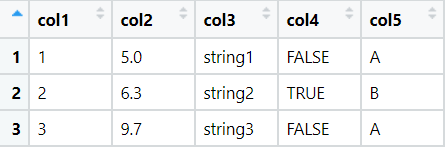Basic mutate operation
Introduction
We can add new columns that are functions of existing columns. We use the mutate(…) function to achieve this. Basic syntax of mutate is:
mutate(<dataframe>, <new_column> = <function_applied_to_old_column>)
The mutate operation does not modify the current input, instead it returns a new dataframe which is a result of the operation performed.
Procedure
We will be working with a custom dataframe.
# package for creating dataframe
library(tibble)
# tibble or dataframe with column names to rename
df <- tibble(col1 = as.integer(c(1,2,3)),
col2 = c(5.0,6.3,9.7),
col3 = c("string1", "string2","string3"),
col4 = c(FALSE, TRUE, FALSE),
col5 = as.factor(c("A","B","A")),
)
View(df)Few rows of the data are:

We will use the mutate operation to:
- double all values in col1 to create new col6
- concatenate strings in col3 with new string “new_string” to create new col7
- create new col8 which is addition of col1 and col2
Code
# refer procedure for definition of df
library(dplyr)
result <- mutate(df,
# double all values in col1 to create new col6
col6 = 2 * col1,
# concatenate strings in col3 with new string "new_string" to create new col7
col7 = paste(col3,"new_string"),
# create new col8 which is addition of col1 and col2
col8 = col1 + col2
)
View(result)The output of above code is:

Conclusion
Thus we have successfully implemented basic mutate function in tidyverse.
References
- https://r4ds.had.co.nz/